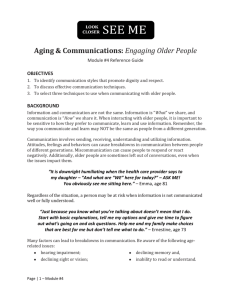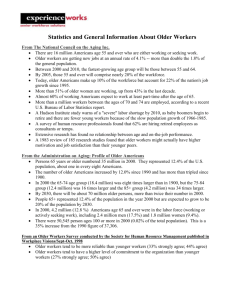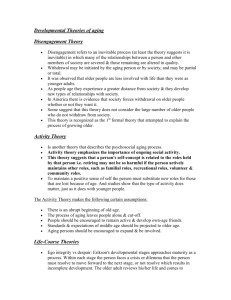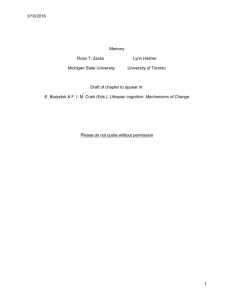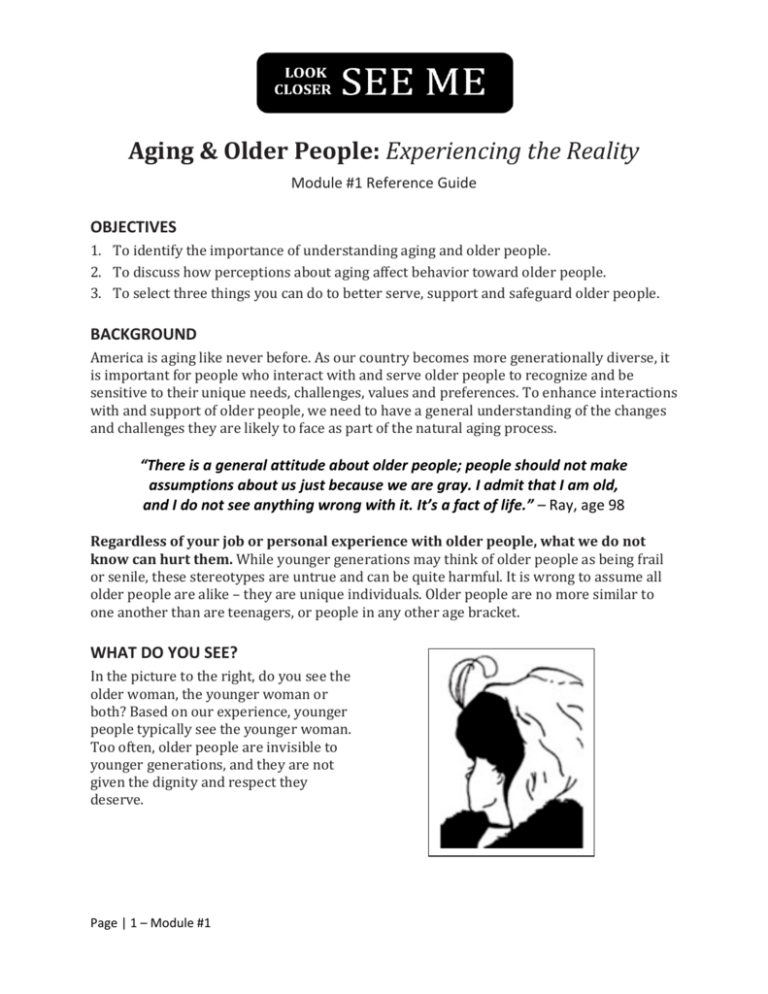
Aging & Older People: Experiencing the Reality
Module #1 Reference Guide
OBJECTIVES
1. To identify the importance of understanding aging and older people.
2. To discuss how perceptions about aging affect behavior toward older people.
3. To select three things you can do to better serve, support and safeguard older people.
BACKGROUND
America is aging like never before. As our country becomes more generationally diverse, it
is important for people who interact with and serve older people to recognize and be
sensitive to their unique needs, challenges, values and preferences. To enhance interactions
with and support of older people, we need to have a general understanding of the changes
and challenges they are likely to face as part of the natural aging process.
“There is a general attitude about older people; people should not make
assumptions about us just because we are gray. I admit that I am old,
and I do not see anything wrong with it. It’s a fact of life.” – Ray, age 98
Regardless of your job or personal experience with older people, what we do not
know can hurt them. While younger generations may think of older people as being frail
or senile, these stereotypes are untrue and can be quite harmful. It is wrong to assume all
older people are alike – they are unique individuals. Older people are no more similar to
one another than are teenagers, or people in any other age bracket.
WHAT DO YOU SEE?
In the picture to the right, do you see the
older woman, the younger woman or
both? Based on our experience, younger
people typically see the younger woman.
Too often, older people are invisible to
younger generations, and they are not
given the dignity and respect they
deserve.
Page | 1 – Module #1
LOOK CLOSER, SEE ME
What do you see, people, what do you see?
What are you thinking, when you look at me?
A crabby old woman, not very wise.
Uncertain of habit, with far-away eyes,
Who dribbles her food and makes no reply.
When you say in a loud voice, “I do wish you’d try!”
Who seems not to notice the things that you do.
And forever is losing a stocking or shoe.
Who, unresisting or not, lets you do as you will.
With bathing and feeding, the long day to fill.
Is that what you’re thinking, is that what you see?
Then open your eyes - you’re not looking at me.
I’ll tell you who I am as I sit here so still!
As I rise at your bidding, as I eat at your will.
I’m a small child of 10 with a father and mother,
Brothers and sisters, who loved one another.
A young girl of 16 with wings on her feet,
dreaming that soon now a lover she’ll meet.
A bride soon at 20 — my heart gives a leap,
Remembering the vows that I promised to keep.
At 25 now I have young of my own.
Who need me to build a secure, happy home.
A woman of 30, my young now grow fast,
Bound to each other with ties that should last.
At 40, my young sons have grown and are gone,
But my man’s beside me to see I don’t mourn.
At 50, once more babies play around my knee,
Again we know children, my loved one and me.
Dark days are upon me, my husband is dead,
I look at the future, I shudder with dread.
For my young are all rearing young of their own.
And I think of the years and the love that I’ve known.
I’m an old woman now and nature is cruel,
‘Tis her jest to make old age look like a fool.
Page | 2 – Module #1
The body is crumbled, grace and vigor depart.
There is now a stone where I once had a heart.
But inside this old carcass a young girl still dwells,
And now and again my battered heart swells.
I remember the joy, I remember the pain,
And I’m loving and living life over again.
I think of the years - all too few, gone too fast And accept the stark fact that nothing can last.
So open your eyes, people, open and see,
Not a crabby old woman - LOOK CLOSER, SEE ME!
THE STORY BEHIND THE POEM
The LOOK CLOSER, SEE ME poem was discovered years ago, as nurses went through the
belongings of an old woman who had died in the geriatric ward of a small hospital in
Scotland. Today, she is known as “Anonymous.” The poem inspired this training and serves
as a simple reminder that older people matter and reflect a lifetime of living.
WHY IS IT IMPORTANT TO BE SENSITIVE TO OLDER PEOPLE?
Generation gaps can occur in as few as 10 years difference in age. Different experiences,
values and influences can lead to feelings of disconnect, discomfort and frustration. Having
a better understanding of what makes a person ‘tick’ can change the course of a
conversation and the outcome of a situation. Although natural aging occurs, older people
are a vibrant and diverse group with years of knowledge and experience.
KEY POINTS TO REMEMBER
Our country is quickly becoming generationally diverse, making it critical for those of us
who interact with, serve and support older people to be aware of and sensitive to their
unique needs, challenges, values and preferences. To serve and safeguard older people, we
need to have a general understanding of the aging process, and the changes and challenges
they experience.
1. Don’t assume older people are all frail and senile because of their age or how they
look. Most older people are living active, independent lives.
2. Disrespectful behavior toward older people could harm their body, mind and spirit.
Older people deserve to be treated with dignity and respect, like anyone else.
3. To serve and help safeguard older people, it is important to be aware of and
sensitive to their unique needs, challenges, values and preferences.
This entire training series is designed to help you better understand, interact with and
safeguard older people.
Page | 3 – Module #1
COPYRIGHT © 2011. University of Cincinnati, Ohio. All rights reserved. Duplication and distribution
without written permission is strictly prohibited. The Generational Diversity and Sensitivity Training was
developed by Charles Puchta and Evelyn Fitzwater of the Center for Aging with Dignity at the University
of Cincinnati College of Nursing. Special thanks to our collaborators from Cincinnati Area Senior Services,
the Council on Aging of Southwest Ohio, The Mayerson Jewish Community Center, and Warren County
Community Services, Inc.
The LOOK CLOSER, SEE ME Generational Diversity and Sensitivity training program
(www.LookCloserSeeMe.org) was made possible by a grant from an anonymous foundation and the
financial support of Marjorie Motch, an active 87-year-old member of the University of Cincinnati
College of Nursing Board of Advisors. Thank you to the many older people and representatives from
various cultural communities who actively participated in this project by reviewing the training materials
and sharing their thoughts, opinions and comments. Thanks also to Arlene de Silva for sharing her
cultural perspective and photos from her book Faces in Aging - www.FacesInAging.org.
FOR MORE INFORMATION
Center for Aging with Dignity
– (513) 558-2428 | www.SafeAfter60.org
University of Cincinnati College of Nursing
– (513) 558-5500 | www.Nursing.UC.edu
DISCLAIMER. Copyright law suggests, unless specifically claimed, it is fair to assume images/information
produced before 1923 to be public domain. As such, the older/younger woman image displayed is
believed to be Public Domain. To date, we have not been able to identify a person or corporation
claiming copyright of the image. Our understanding is the image is attributed to W.E. Hill's original
artwork in a 1915 article in Puck magazine.
Page | 4 – Module #1

